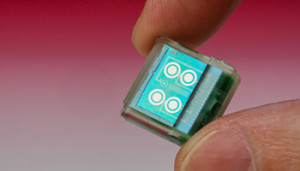Implantable chips could change the way doctors monitor chronic conditions and administer medications, while providing pathologists with an opportunity to analyze a new stream of diagnostic data
Researchers continue to make progress on implantable diagnostic devices that are designed to monitor the same types of biomarkers used in some clinical laboratory tests. These devices are designed to provide continuous patient monitoring and can transmit data in real time to care providers and medical laboratories.
Miniature Laboratory on a Chip
Implantable medical devices have been around for quite some time. However one particular device developed by Sandro Carrara, PhD, and Giovanni De Micheli, PhD, at the Ecole Polytechnique Federale de Lausanne (EPFL), works more like a tiny laboratory than previous generations of implantable devices.
“This is the world’s first chip capable of measuring not just pH and temperature, but also metabolism-related molecules like glucose, lactate, and cholesterol, as well as drugs,” stated Carrara in R&D Magazine.
Battery-Powered Implantable Diagnostic Device
The implantable diagnostic device designed by Carrara and De Micheli consists of three main components:
• a circuit with six sensors;
• a control unit; and,
• a radio transmission module.
It is powered by an external battery patch that is placed on the patient’s skin.

This biosensing chip has been created by researchers in EPFL’s Integrated Systems Laboratory. (Photo/caption copyright: Alain Herzog/EPFL.)
Each of the six sensors is coated with a different enzyme. This enables the device to monitor various substances. “Potentially, we could detect just about anything, but the enzymes have a limited lifespan, and we have to design them to last as long as possible,” said De Micheli in a 2013 Daily Mail article.
The developers expect that the device will be most useful for monitoring patients with chronic conditions and those who are undergoing chemotherapy. “Knowing the precise and real-time effect of the drugs on the metabolism [of a patient] is one of the keys to the personalized, precision medicine that we are striving for,” said Carrara.

Sandro Carrara, PhD, (left) is Maître d’Enseignement et de Recherche (Master of Teaching and Research) at the Ecole Polytechnique Federale University de Lausanne (EPFL) in Lausanne, Switzerland, former Professor of Optical and Electrical Biosensors at the Department of Electrical Engineering and Biophysics (DIBE) of the University of Genoa, Italy, and former Professor of Nanobiotechnology at the University of Bologna, Italy. Giovanni De Micheli, PhD, (right) is Professor and Director of the Institute of Electrical Engineering and of the Integrated Systems Centre at EPFL. They participated in a multidisciplinary team that included researchers from EPFL’s Integrated Systems Laboratory and the Radio Frequency Integrated Circuit Group to develop the biosensing chip. (Photos copyrights: MeMeA and EPFL respectively.)
Other Research Involving Implantable Devices
Implantable devices have been in use for approximately 60 years. As technology has advanced implantable devices have become increasingly sophisticated, and applications have widened to include diagnostics.
For example, in 2014, a second patent was granted to the University of Rochester for a device called the CytoComm Living Biosensor System, which “contains live cells that are engineered to detect specific biochemical found in the body,” according to a news article published by the university.
More recently, engineers at Stanford University developed an implantable device that can deliver optogenetic signals using energy from the body in which it is implanted. The team at Stanford implanted a tiny device in mice that uses light to control activity in the brain. It is powered through energy created when the mice move.
Possible Chemotherapy Applications for Implantable Devices
Anatomic pathologists who analyze biopsies will be interested in another potential use of these devices. For cancer patients receiving chemotherapy, implantable devices could radically alter the course of their treatment.
For instance, biopsies are important, but invasive. Therefore, new implantable device are under development that are designed to be inserted and left behind when a biopsy is collected. This device could then provide information to alert doctors to metastasis or tumors earlier and might also reduce the need for additional biopsies. Researchers published a paper on one such device for the international science journal Biosensors & Bioelectronics.
Such implantable devices could also lessen the side effects of chemotherapy by enabling doctors to more precisely manage dosages. Currently chemotherapy is administered based on the patient’s height and weight. Dosages based on biomarkers would be far more individualized. In fact, monitoring of the diagnostic and patient-monitoring information transmitted by implantable devices like these could create new opportunities for pathologists, PhDs and lab scientists, and could be a new service for clinical laboratories.
Similarly, devices such as the one being developed at EPFL may be useful in managing chronic conditions. Monitoring biomarkers in vivo and in real time could help doctors know when drugs should be administered or stopped. Neuromodulation devices, for example, are being developed that help people who have conditions such as rheumatoid arthritis and Crohn’s disease.
The Future of Implantable Biomedical Research
Although there are many implantable devices in use, those that are designed to provide diagnostic information are still under development. The chip that Carrara and De Micheli are working on has been tested successfully in vivo on mice at the Institute for Research in Biomedicine (IRB).
Successful results of that testing mean that clinical tests on humans could be as little as three to five years away. And, because the device is implanted just below the surface of the skin, it is a minimally invasive procedure, which could help speed testing.
As research continues, there are sure to be many more uses for implantable devices. For patients with chronic conditions, a device that can reduce the number of invasive procedures or alert doctors before the occurrence of an exacerbation that requires emergency care would improve quality of life. Devices that could allow doctors to pinpoint the exact amount of a chemotherapeutic agent to administer to a cancer patient could reduce side effects and perhaps make recovery easier.
There are a significant number of research and biotech teams working to develop implantable diagnostic devices. Thus, pathologists and clinical laboratory managers may want to track progress in this field and develop ways for their labs to participate in monitoring the real-time transmission of this data and how it is interpreted and acted upon by the patients’ physicians.
—Dava Stewart
Related Information:
Chip Placed Under Skin Provides Precise Medicine
Development of Implantable Medical Devices: From an Engineering Perspective
Implantable Medical Devices Market Driven by High Incidence of Chronic Diseases in the U.S.
Implantable Diagnostic Technology Advances
Stanford Engineers Develop a Wireless, Fully Implantable Device to Stimulate Nerves in Mice
Implantable Diagnostic Device For Cancer Monitoring
Scientists Weigh In On Neuromodulation Devices to Treat Chronic Inflammatory Diseases
Tiny Implantable Blood Test Chip Could Personalise Medicine



